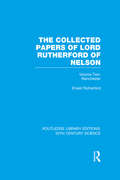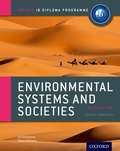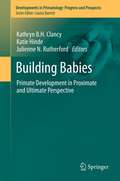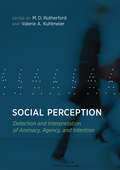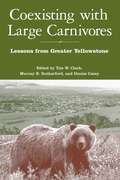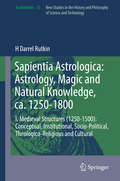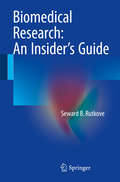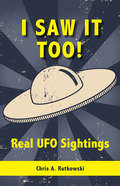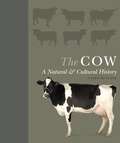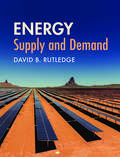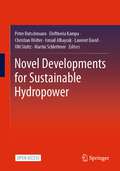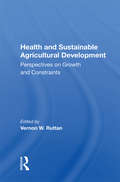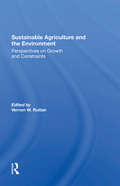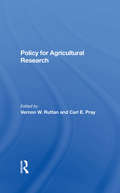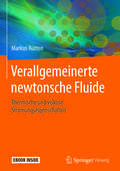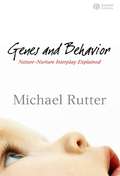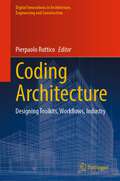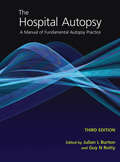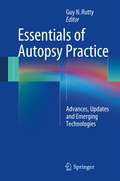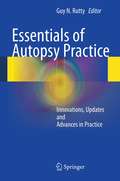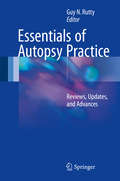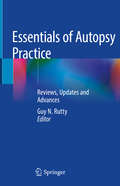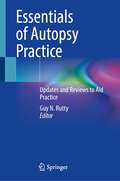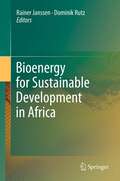- Table View
- List View
The Collected Papers of Lord Rutherford of Nelson: Volume 2 (Routledge Library Editions: 20th Century Science)
by Ernest RutherfordThis is the second of three volumes which together contain the complete range of Lord Rutherford’s scientific papers, incorporating in addition addresses, general lectures, letters to editors, accounts of his scientific work and personal recollections by friends and colleagues. Volume two, first published in 1963, includes the papers published by Rutherford when professor of Physics at Manchester, 1907 to 1919. While the work of his laboratory ranged over the whole field of radioactivity, he himself devoted much effort to questions concerning the nature and properties of the α particle. Consideration of the scattering of α particles led him to the second of his outstanding achievements, the conception of the nuclear structure of the atom, which opened up a new era in Physics. In each volume can be found photographs of Rutherford and his collaborators, multiple graphs, tables, diagrams and charts, and also pictures of the original apparatus which is of historic interest.
IB Environmental Systems and Societies: Oxford IB Diploma Programme (2015 Edition)
by Jill Rutherford Gillian WilliamsThe IB Diploma Program course books are resource materials designed to support students throughout their two-year Diploma Program course of study in a particular subject. They will help students gain an understanding of what is expected from the study of an IB Diploma Program subject while presenting content in a way that illustrates the purpose and aims of the IB. They reflect the philosophy and approach of the IB and encourage a deep understanding of each subject by making connections to wider issues and providing opportunities for critical thinking. In addition, the course books provide advice and guidance on the specific course assessment requirements and on academic honesty protocol.
Building Babies: Primate Development in Proximate and Ultimate Perspective (Developments in Primatology: Progress and Prospects #37)
by Julienne N. Rutherford Kathryn B.H. Clancy Katie HindeThe ontogeny of each individual contributes to the physical, physiological, cognitive, neurobiological, and behavioral capacity to manage the complex social relationships and diverse foraging tasks that characterize the primate order. For these reasons Building Babies explores the dynamic multigenerational processes of primate development. The book is organized thematically along the developmental trajectory:conception, pregnancy, lactation, the mother-infant dyad, broader social relationships, and transitions to independence. In this volume, the authors showcase the myriad approaches to understanding primate developmental trajectories from both proximate and ultimate perspectives. These collected chapters provide insights from experimental manipulations in captive settings to long-term observations of wild-living populations and consider levels of analysis from molecule to organism to social group to taxon. Strepsirrhines, New World monkeys, Old World monkeys, apes, and humans are all well-represented. Contributions by anthropologists, microbiologists, psychologists, population geneticists, and other primate experts provide Building Babies a uniquely diverse voice. Building Babies features multi- and trans-disciplinary research approaches to primate developmental trajectories and is particularly useful for researchers and instructors in anthropology, animal behavior, psychology, and evolutionary biology. This book also serves as a supplement to upper-level undergraduate courses or graduate seminars on primate life history and development. In these contexts, the book provides exposure to a wide range of methodological and theoretical perspectives on developmental trajectories and models how researchers might productively integrate such approaches into their own work.
Social Perception: Detection and Interpretation of Animacy, Agency, and Intention (The\mit Press Ser.)
by M. D. Rutherford Valerie A. KuhlmeierAn interdisciplinary exploration of perceptual and cognitive processes underlying the ability to perceive social information, drawing on current research and new experimental techniques.As we enter a room full of people, we instantly have a number of social perceptions. We have an automatic perception of others as subjective agents with their own points of view, thoughts, and goals, and we can quickly interpret minimal visual information to infer that something is animate. This book explores the perceptual and cognitive processes that allow humans to perceive and understand this social information quickly and apparently effortlessly. Top researchers in fields ranging from developmental psychology to vision science consider the perception of biological and animate motion, inferences based on this motion, and the early development of these abilities. These innovative contributions reflect a recent renewal of interest in the attribution of agency and the understanding of goal-directed behavior, which has been accompanied by a rapid increase in empirical discoveries enabled by such new experimental techniques as brain imaging. The research presented in Social Perception suggests that an intuitive understanding of others is an integral part of human psychology, develops early, relies on a network of brain regions, and may be compromised in autism.ContributorsDare Baldwin, Lara Bardi, H. Clark Barrett, Erin Cannon, You-jung Choi, Willem E. Frankenhuis, Tao Gao, Emily D. Grossman, Antonia Hamilton, Petra Hauf, Valerie A. Kuhlmeier, Jeff Loucks, Scott A. Love, Yuyan Luo, Elena Mascalzoni, Phil McAleer, Richard Ramsey, Lucia Regolin, M.D. Rutherford, Kara Sage, Brian J. Scholl, Maggie Shiffrar, Francesca Simion, Jessica Sommerville, James P. Thomas, Nikolaus Troje, Amanda Woodward
Coexisting with Large Carnivores: Lessons From Greater Yellowstone
by Murray Rutherford Denise Casey Tim ClarkAs in the rest of the United States, grizzly bears, wolves, and mountain lions in and around Yellowstone National Park were eliminated or reduced decades ago to very low numbers. In recent years, however, populations have begun to recover, leading to encounters between animals and people and, more significantly, to conflicts among people about what to do with these often controversial neighbors. Coexisting with Large Carnivores presents a close-up look at the socio-political context of large carnivores and their management in western Wyoming south of Yellowstone National Park, including the southern part of what is commonly recognized as the Greater Yellowstone Ecosystem. The book brings together researchers and others who have studied and worked in the region to help untangle some of the highly charged issues associated with large carnivores, their interactions with humans, and the politics that arise from those interactions. This volume argues that coexistence will be achieved only by a thorough understanding of the human populations involved, their values, attitudes, beliefs, and the institutions through which carnivores and humans are managed. Coexisting with Large Carnivores offers important insights into this complex, dynamic issue and provides a unique overview of issues and strategies for managers, researchers, government officials, ranchers, and everyone else concerned about the management and conservation of large carnivores and the people who live nearby.
Sapientia Astrologica: I. Medieval Structures (1250-1500): Conceptual, Institutional, Socio-Political, Theologico-Religious and Cultural (Archimedes #55)
by H Darrel RutkinThis book explores the changing perspective of astrology from the Middle Ages to the Early Modern Era. It introduces a framework for understanding both its former centrality and its later removal from legitimate knowledge and practice. The discussion reconstructs the changing roles of astrology in Western science, theology, and culture from 1250 to 1500. The author considers both the how and the why. He analyzes and integrates a broad range of sources. This analysis shows that the history of astrology—in particular, the story of the protracted criticism and ultimate removal of astrology from the realm of legitimate knowledge and practice—is crucial for fully understanding the transition from premodern Aristotelian-Ptolemaic natural philosophy to modern Newtonian science. This removal, the author argues, was neither obvious nor unproblematic. Astrology was not some sort of magical nebulous hodge-podge of beliefs. Rather, astrology emerged in the 13th century as a richly mathematical system that served to integrate astronomy and natural philosophy, precisely the aim of the “New Science” of the 17th century. As such, it becomes a fundamentally important historical question to determine why this promising astrological synthesis was rejected in favor of a rather different mathematical natural philosophy—and one with a very different causal structure than Aristotle's.
Biomedical Research: An Insider's Guide
by Seward B. RutkoveThis comprehensive yet concise title is a guide to introducing people at all levels of training--undergraduate students, graduate students, medical students, residents, fellows and junior faculty--to the basic joys and pains of research. In doing so, this fun and easy-to-read guide offers thorough information to allow people to determine for themselves whether research is really for them. By outlining all of the key issues in a biomedical research career, would-be and early-stage researchers will not only be better informed about the world of biomedical research, but will learn a basic set of instructions to help initiate their careers. Biomedical Research: An Insider's Guide is divided into several sections. The first focuses on decision points regarding whether one wants to enter into research and which type for which type of person--basic, clinical, or translational. The second section focuses on some basic practicalities of pursuing medical research, including institutional review boards and animal care committees as well general suggestions regarding idea generation and collaboration. The third section covers a core aspect of research: writing--detailing the writing of both grants and papers. The fourth section addresses a range of issues, including conferencing to patents to industry to philanthropy. The final section deals with the all-important broader life issues from job choices to thoughts on trying to keep the big picture front and center as one moves through a research-infused career. An invaluable resource that offers insightful, practical advice, Biomedical Research: An Insider's Guide is the go-to guide that shows how biomedical research is not only filled with multiple challenges, but is also truly and inexplicably enjoyable.
I Saw It Too!: Real UFO Sightings
by Chris A. RutkowskiAlthough many adults believe they have had encounters with strange creatures from alien spaceships, not everyone has actually reported their experiences to official investigators. But if you’re a young person it’s even less likely that people will believe you and more likely that your story will never be officially recorded. After all, who would believe a kid? I Saw It Too! is the first collection of stories told by children, documenting what they saw and when they saw it. These accounts are real cases of UFOs they’ve seen or alien creatures they’ve encountered that were reported to government or military officials, UFO investigators, and journalists. Inside you will find eighteen of these strange, fascinating, and believable tales recounted by young people from around the world with story illustrations by Stacey Archer with Lonigan Gilbert. The truth is really out there, and renowned ufologist Chris Rutkowski has tracked it down!
The Cow: A Natural and Cultural History
by Professor Catrin RutlandA richly illustrated introduction to the science and history of the cowWe populate the countryside with cows the world over, and their familiar presence ensures that global demands for milk and beef are met. But with more than a billion cattle on the planet, the importance of cows extends well beyond food production. Cows are venerated by some religions and shunned by others; they provide leather for shoes, clothing, and other uses; and they have long been central to the agricultural way of life, working the fields, pulling carts, and providing fertilizer. The Cow is a comprehensive guide to help us understand these important animals, offering a wealth of information about their anatomy and behaviors, breed varieties, and place in human culture past and present. Exploring the cow’s livestock credentials and beyond, this book combines engaging and informative text, beautiful photographs, and explanatory diagrams to examine the cow's fascinating biology, its hard-wired behaviors, and its relationship with humankind.Provides an in-depth look at the evolution of the cow, its role in agriculture, and the development of breedsIncludes chapters on Anatomy & Biology, Society & Behavior, and Cattle & PeopleFeatures a photographic directory of forty global cattle breeds
The Electronics of Radio
by David B. RutledgeThis innovative book provides a stimulating introduction to analog electronics by analyzing the design and construction of a radio transceiver. The author provides essential theoretical background at each step, along with carefully designed laboratory and homework exercises. This structured approach ensures a good grasp of basic electronics as well as an excellent foundation in wireless communications systems. The author begins with a thorough description of basic electronic components and simple circuits. He then describes the key elements of radio electronics, including filters, amplifiers, oscillators, mixers, and antennas. In the laboratory exercises, he leads the reader through the design, construction, and testing of a popular radio transceiver (the NorCal 40A), thereby illustrating and reinforcing the theoretical material. A diskette containing the widely known circuit simulation software, Puff, is included in the book. This book, the first to deal with elementary electronics in the context of radio, can be used as a textbook for introductory analog electronics courses, or for more advanced undergraduate classes on radio-frequency electronics. It will also be of great interest to electronics hobbyists and radio enthusiasts.
Energy: Supply and Demand
by David B. RutledgeFocusing on trends in energy supply and demand, this text provides students with a comprehensive account of the subject and an understanding of how to use data analysis and modeling to make future projections and study climate impacts. Developments in technology and policy are discussed in depth, including the role of coal, the fracking revolutions for oil and gas, the electricity grid, wind and solar power, battery storage, and biofuels. Trends in demand are also detailed, with analysis of industrial demands such as LEDs, air conditioning, heat pumps, and information technology, and the transportation demands of railroads, ships, and cars (including electric vehicles). The environmental impacts of the energy industry are considered throughout, and a full chapter is dedicated to climate change. Real-life case studies and examples add context, and over 400 full-color figures illustrate key concepts. Accompanied by a package of online resources including solutions, video examples, sample data, and PowerPoint slides, this is an ideal text for courses on energy and is accessible to a range of students from engineering and related disciplines.
Novel Developments for Sustainable Hydropower
by Peter Rutschmann Eleftheria Kampa Christian Wolter Ismail Albayrak Laurent David Ulli Stoltz Martin SchlettererThis open access book presents (selected) new and innovative developments for sustainable and fish-friendly hydropower. It offers unique insights into the challenges, practices and policies of hydropower developments across 8 European countries, providing examples from on-site studies and European-wide analyses. The case studies throughout the book are practical “real-world” examples, which are intended to serve as inspiration for anyone who would like to know more about how solutions for more sustainable hydropower production can be designed and implemented. Hydropower is an important renewable energy source, which, however, can also impact aquatic ecosystems, fish populations and hydro-morphology. EU and national water, environmental and energy legislation strive for sustainable energy and water resource management as well as the protection of important habitats and species. These have an effect on the requirements and decision making processes for hydropower planning, commissioning and operation. With a high variety of measures existing and site-specific conditions as well as national and EU level legal requirements to consider, it can be difficult to determine, what issues to address and which measures to implement.
Health And Sustainable Agricultural Development: Perspectives On Growth And Constraints
by Vernon W. RuttanThis book explores the role of health in sustainable agricultural development into the early decades of the twenty-first century. It focuses on emerging agricultural research priorities in developed and developing economies in response to the demands placed on their agricultural systems.
Sustainable Agriculture And The Environment: Perspectives On Growth And Constraints
by Vernon W RuttanThis book explores the resource and environmental constraints on sustainable growth in agricultural production into the middle of the twenty-first century. It presents contemporary concerns with the implications of natural resource availability and environmental change.
Policy For Agricultural Research
by Vernon W Ruttan Carl E Pray Robert Evenson Prabhu L PingaliThe contributors to this volume, based on the Agriculture Research Seminars held annually at the University of Minnesota, examine the role of government, multinationals, and the emerging private sector (in both domestic and international contexts) in determining agricultural research policy.
Verallgemeinerte newtonsche Fluide
by Markus RüttenNichtnewtonsche Fluide, zu denen die verallgemeinerten newtonschen Fluide zählen, zeichnen sich dadurch aus, dass ihre Viskosität nicht nur von Druck und Temperatur abhängt. Vielmehr wirkt sich die Strömung selbst auf die Viskosität der Fluide aus. Das macht die Physik und Strömungsmechanik dieser Fluide außerordentlich komplex. Das Buch führt daher umfassend in die Theorie und Anwendung der verallgemeinerten newtonschen Fluide ein. Neben ausführlichen Herleitungen der Gesetzmäßigkeiten werden Lesern die strömungsphysikalischen Phänomene, die bei diesen Fluiden auftreten, anhand analytischer Beispiele und praxisnaher Strömungssimulationen veranschaulicht. Die gängigsten Fluidmodelle werden vorgestellt und ihre jeweiligen Modellierungsgrenzen aufgezeigt. Viskoelastische Fluide werden im Gegensatz zur gängigen Fachliteratur bewusst nur am Rande behandelt, vielmehr wird der Temperatureinfluss auf die rheologischen Fluideigenschaften betrachtet.Für Studierende der Ingenieurwissenschaften sowie für Praktiker sind die strömungsmechanischen Aspekte der Rheologie von besonderer Bedeutung, denn diese Fluide sind für zahlreiche Industriesparten relevant. Ohne Kenntnisse ihrer Eigenheiten können viele Problemstellungen in der Chemie-, Prozess- und Verfahrenstechnik nicht bearbeitet werden. Bei der Produktion von Farben, Lacken, Dispersionen und Emulsionen beispielsweise, aber auch bei Kunststoffschmelzen sind die Effekte strömungsbedingt veränderlicher Viskosität entscheidend für die Qualität des Endprodukts. Ähnliches gilt für die Prozesstechnik, Hydraulik oder die Getriebe- und Motorenentwicklung. Die ZielgruppenDas Buch wendet sich an Praktiker in den Bereichen chemische Verfahrenstechnik, Lebensmitteltechnologie und Biofluiddynamik sowie an Studierende der Ingenieurwissenschaften.
Genes and Behavior: Nature-Nurture Interplay Explained
by Michael RutterIn this major new book, eminent scientist Professor Sir Michael Rutter gets behind the hype of the behavioral genetics debate to provide a balanced and authoritative overview of the genetic revolution and its implications for understanding human behavior. Written by one of the world's leading figures in child psychology and psychiatry, Professor Sir Michael Rutter Provides non-technical explanation of genetics to diffuse the sensational debates surrounding the topic Sets out in layman's terms what genes do, how much is nature and how much is nurture Argues that nature and nurture are not truly separate and gives examples of how the two interact Looks at the implications of genetic findings for policy and practice The book will inform public debate about the implications of the Human Genome Project and, more broadly, the field of genetic science.
Coding Architecture: Designing Toolkits, Workflows, Industry (Digital Innovations in Architecture, Engineering and Construction)
by Pierpaolo RutticoThis book provides a clear picture of how computational processes are gradually permeating and innovating the Architecture, Engineering, and Construction sector, contributing to sustainability and aesthetic evolution. It achieves that by gathering a collection of accounts shared by pioneering professionals involved in this innovation, drawing from recent academic studies, ongoing experimental processes conducted in cutting-edge architectural and engineering offices, as well as innovative industrial applications. The covered subjects span a wide range, including artificial intelligence and robotic manufacturing, the metaverse and 3D printing, strategies to counter CO2 consumption through plug-ins, as well as emerging materials and construction techniques. The chapters feature authors who are pioneers and embrace roles like software developers, architects, process engineers, academics, and forward-thinking entrepreneurs. They represent authoritative references within a broader interconnected cultural and technological system; an eclectic system that finds in computational processes the key to addressing the new challenges of contemporary architecture.
The Hospital Autopsy: A Manual of Fundamental Autopsy Practice, Third Edition
by Guy Rutty Julian BurtonNow in full colour, this new and revised edition of The Hospital Autopsy presents a clear and systematic approach to safe and effective modern autopsy practice for pathologists. It begins by discussing issues such as legislation governing autopsies, religious attitudes and ensuring safety, before covering the procedures of external examination, evi
Essentials of Autopsy Practice: Advances, Updates and Emerging Technologies
by Guy N. RuttyThis book covers new and exciting topics which have emerged in the area of autopsy recently, including the three different post-mortem CT-angiography systems currently available to practitioners in this field; a highly topical chapter on the role of genetic abnormalities in the handling of drugs within the body and how this can affect the interpretation of toxicological results in relation to how the drug may have caused or contributed to death; an update on the current classification and considerations related to deaths due to hanging; a review of injuries and fatalities caused by animals including post-mortem scavenging; an authoritative review of poisons and toxins from water and the life that inhabits it; and recent advances in knowledge in the use of entomology as an investigative tool as well as knowledge related to colonisation of cadavers by insects, animals and birds. Essentials of Autopsy Practice: Advances, Updates and Emerging Technologies is a multi-subject book, aimed at different grades of practitioners, from different practice areas, covering topics that are currently discussed and anticipated to be discussed in the field of autopsy practice over the next few years.
Essentials of Autopsy Practice
by Guy N. RuttyEssentials of Autopsy Practice: Innovations, Updates and Advances in Practice is the fifth volume in the Essentials in Autopsy Practice series, covering topics of current and future interest. Designed to keep all involved in the investigation of death abreast of changes within the field, this volume covers a wide range of topical areas which can be encountered around the world. Essentials of Autopsy Practice: Innovations, Updates and Advances in Practice covers death by drowning; deaths from extreme temperature; the radioactive autopsy; chemical contamination and the autopsy; blast injuries; forensic odontology identification; and determination of the force used to cause an injury. Useful to both trainees and consultants in all specialty areas within pathology, including forensic pathology, Essentials of Autopsy Practice: Innovations, Updates and Advances in Practice also serves as a guide to all those involved in death investigation, i.e. nurses, lawyers, paramedics and police officers.
Essentials of Autopsy Practice
by Guy N. RuttyEssentials of Autopsy Practice is dedicated to updating the modern pathologist on the issues related to the autopsy. This first volume contains 12 topical chapters which are not covered in any other text. It comprises the most recent developments in current autopsy and relevant subjects that have not yet been covered in current autopsy textbooks. This is what makes this book exceptional in its field. The book will be of interest to both trainees and consultants in all sub-branches of pathology including forensic pathology. The subject matter will also appeal to other areas of clinical medicine and will make a good reference book.
Essentials of Autopsy Practice: Reviews, Updates and Advances
by Guy N. RuttyThis book covers topical subjects within the field of death investigation, where changes in practice have recently occurred. The topics embrace the multi-disciplinary approach required for death investigation, and address advances in the field of forensic photography, pathology, and 3D printing as applied to forensics. This volume includes chapters on high altitude deaths, the role of 3D-printing applied to forensic investigations, photogrammetry, commotion cordis (an uncommon cause of fatal cardiac arrest) and the cricoid cartilage. Essentials of Autopsy Practice: Reviews, Updates and Advances is an educational and practical resource aimed at trainees and consultants, generalists and specialists, and multi-disciplinary teams.
Essentials of Autopsy Practice: Updates and Reviews to Aid Practice
by Guy N. RuttyThis book covers topical subjects within the field of death investigation, where changes in practice have recently occurred. The topics embrace the multi-disciplinary approach required for death investigation, and address advances in the fields of forensic fractography in relation to road traffic death investigations, pathology, MicroCt and 3D printing as applied to forensics. Chapters are written in a uniform easy-to-follow format to ensure they are accessible to both specialists and non-specialists in the field. Essentials of Autopsy Practice — Updates and Reviews to Aid Practice is a practical focused resource covering the latest advances in autopsy practice, making it an ideal resource for trainees, consultants, generalists and specialists, along with multi-disciplinary teams working in this field.
Bioenergy for Sustainable Development in Africa
by Dominik Rutz Rainer JanssenThe work builds on the results of the COMPETE Bioenergy Competence Platform for Africa, which was supported by the European Commission and coordinated by WIP Renewable Energies, Germany. The five sections cover biomass production and use, biomass technologies and markets in Africa, biomass policies, sustainability, and financial and socio-economic issues. This valuable work is, in effect, a single-source treatment of a key energy sector in a part of the world which still has a lot of unrealised potential for development.
